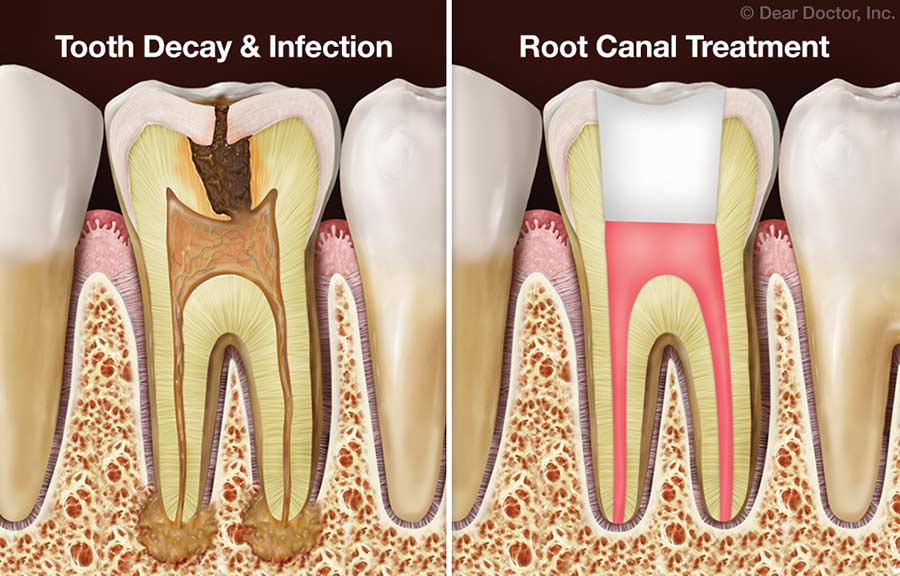Root canal treatment is designed to eliminate bacteria from the infected root canal, prevent reinfection of the tooth and save the natural tooth. When one undergoes a root canal, the inflamed or infected pulp is removed and the inside of the tooth is carefully cleaned and disinfected, then filled and sealed.
What is Root Canal Treatment?
A root canal is an endodontic procedure in which your family dentist removes a diseased or inflamed dental pulp.
The dental pulp is the soft tissue and the inner structure of the teeth that contains blood vessels, connecting tissue, and nerves. This pulp provides blood supply and nerve supply to the tooth. Once the pulp becomes inflamed or infected by a disease, decay, or direct trauma to the tooth, most patients will notice severe pain.
We remove the infected pulp which is inflamed or dead and clean out the complete root of the tooth and sealed it with artificial material to eliminate pain.
What is the procedure for Root Canal Treatment?
- Preparing the area
The dentist begins by numbing the area. Injections are used to send the numbing agent into the gums and the tooth’s root. Once the area is numbed, the dentist places a dental dam in the mouth. This isolates the tooth that needs the root canal by covering the rest of the teeth in the mouth. - Accessing and cleaning the roots
Next, the dentist drills through the tooth to access the root canals and pulp chamber. The dentist uses instruments to clean out the pulp chamber and root canals. An antibacterial and antiseptic solution is used to clean and disinfect the canals. This eliminates the bacteria and treats the infection located in the canals. - Shaping the canals
The dentist must place a filling in the root canals. First, the canals must be shaped. The dentist will use tiny instruments to shape the canals, so they will be ready to receive the filling material. Once shaped, the canals are cleaned a second time. - Filling the canals
The dentist will use gutta-percha to fill the canals. This rubber-like material is placed inside the canals and then heated. The dentist compresses it, so it fits snuggly against the walls. The dentist adds adhesive cement to further seal the canals. Properly sealed canals keep bacteria out. - Filling to the access hole
The dentist must also seal the hole made to access the canals. The filling prevents bacteria from entering the tooth. The dentist also might need to place a post in a canal to strengthen the tooth. This is only necessary if the tooth is severely damaged and cannot support restoration on its own. - Healing and antibiotics
The dentist might send the patient home with a prescription for antibiotics. The medication kills the rest of the infection. The patient will also have post-care instructions. It is normal to experience some discomfort for a few days after the procedure. Over-the-counter pain medications usually alleviate the discomfort. - Adding the crown
If the root canal was on the back tooth or the tooth has significant damage, the patient will need to come back for a crown. The crown is placed around the treated tooth and adds strength and stability. The permanent crown is fabricated to match the existing teeth. Once placed, the tooth can handle the forces of chewing once again.
What is the cost of the treatment?
This one of the most common dental procedure requires expertise and thus, this procedure will depend on cavities, roots of tooth, canal of root and available tooth structure. So it varies from 3k to 10k.



